
Note: Supplemental materials are not guaranteed with Rental or Used book purchases.
Purchase Benefits
Looking to rent a book? Rent Advertising Media Planning, Seventh Edition [ISBN: 9780071703123] for the semester, quarter, and short term or search our site for other textbooks by Baron, Roger; Sissors, Jack Z.. Renting a textbook can save you up to 90% from the cost of buying.
About the Authors
Jack Z. Sissors was a profession of media planning and strategy at Northwestern University. He created and edited The Journal of Media Planning and spent many years working with Leo Burnett and other top advertising agencies.
Roger Baron is the senior vice president and director of media research at DRAFTFCB in Chicago, whose clients include Kraft Foods, SC Johnson, CoorsMiller Brewing Company, Boeing Aircraft, Starbucks, Quaker Oats, Taco Bell and Merck Pharmaceuticals. A member of the ARF Media Communications Council, he is the past president of the Media Research Club of Chicago. He is a frequent speaker at Advertising Research Foundation and other industry conferences.
The New copy of this book will include any supplemental materials advertised. Please check the title of the book to determine if it should include any access cards, study guides, lab manuals, CDs, etc.
The Used, Rental and eBook copies of this book are not guaranteed to include any supplemental materials. Typically, only the book itself is included. This is true even if the title states it includes any access cards, study guides, lab manuals, CDs, etc.